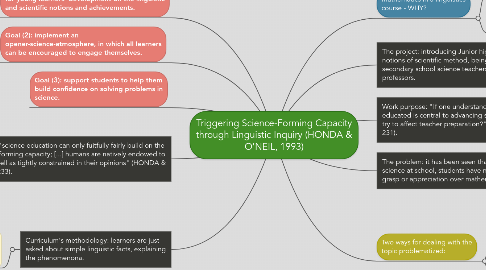
1. Mathematics in a linguistics course - WHY?
1.1. Sets and logic theory.
1.2. Human language and number faculty both have the property of discrite infinity.
2. The project: introducing Junior high school students some notions of scientific method, being developed by secondary school science teachers and university professors.
2.1. The distinction of this study: examining the learning process with secondary science teachers and in the science curriculum.
3. Work purpose: "If one understands that the way teachers are educated is central to advancing science education, why not try to affect teacher preparation?" (HONDA & O'NEIL, 1993: 231).
3.1. Besides presenting the most relevant aspects on first and second language acquisition, the group attempted to improve people's science knowledge.
4. The problem: it has been seen that, after years studying science at school, students have not showed a great deal of grasp or appreciation over mathematic and scientific subjects.
4.1. Moreover, the majority of Wheelock College is female and it is known that women public has suffered lack of instimulation for science engagement and confidence.
4.1.1. Teachers must develop more spaces for equal opportunities so students can expose more themselves to science, especially female learners.
5. Goal (1): promote students' and future teachers for young learners' development on the linguistic and scientific notions and achievements.
6. Goal (2): implement an opener-science-atmosphere, in which all learners can be encouraged to engage themselves.
7. Goal (3): support students to help them build confidence on solving problems in science.
8. The belief that "science education can only fuitfully fairly build on the mind's science-forming capacity; [...] humans are natively endowed to do science as well as tightly constrained in their opinions" (HONDA & O'NEIL, 1993: 233).
8.1. Students acquire a first language and, occasionaly, a second, third, n-th ones; considering these learners have well developed their tacit knowldge on languages, the same can be done when trying to reach a depth understanding on science through Socratic introspection and cooperative inquiry.
8.1.1. "the related mathematics part of our curriculum will build on the tacit knowledge that students bring to these studies simply by virtue of their cognitive maturity" (HONDA & O'NEIL, 1993: 234).
8.1.2. Scientific view of language in tension with school grammar.
8.1.3. Science is for making questions about the world we live, not only necessarily "giving solutions".
9. Curriculum's methodology: learners are just asked about simple linguistic facts, explaining the phenomenona.
9.1. They are given, after that, brief linguistic problems (syntax and phonology).
9.1.1. Then, besides coming up with the linguistic situation and its notion, students are also supposed to include data collection, data classification and hypothesis development.
9.1.2. Generalization of the hypothesis.
9.1.3. The authors expect that, working together, students can build a theory about constant revision.
